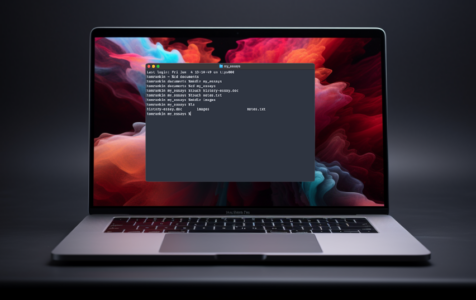The provided instructions and tips in this article aim to guide and assist users in understanding and navigating the Terminal on macOS. Ensure accuracy when using any tool or application by double-checking and understanding commands before executing them. If unsure, always seek additional resources or expert advice. Disclamer
Terminal on macOS is a built-in application that allows users to input direct commands. While its interface resembles a text editor, it is a powerful tool for tasks such as file organization, system settings adjustment, and automation through command input.
How to Access Terminal on Mac (Also Known as Command Prompt)
Below are the steps on how to open the command prompt (or Terminal) on your Mac:
- Spotlight: Press the Cmd (command) key and the Space bar at the same time. Then type “Terminal” into the search that appears and press the Enter key.
- Launchpad: Look for Terminal, typically found in the ‘Other’ folder.
- Finder: Navigate to Applications > Utilities > Terminal.
Basic Commands
Commands are executed by typing them and pressing Return.
Pro Tip: Scan your Mac for performance issues, junk files, harmful apps, and security threats
that can cause system issues or slow performance.
Special offer. About Outbyte, uninstall instructions, EULA, Privacy Policy.
cd: This command changes the folder you’re “looking at” in Terminal. Think of it as opening a different folder on your computer.
ls: This command shows all files and folders in your current location, similar to viewing items in a desktop folder.
- Detailed view:
ls -l
open: This command lets you open a file or folder, just as if you double-clicked on it.
- Example:
open [filename]
touch: Create an empty file.
- Example:
touch [filename]
mkdir: Create a new directory.
- Example:
mkdir [directory_name]
rm: This command deletes files or folders. Exercise caution; deleted items cannot be easily recovered.
- Confirm before deleting:
rm -i [filename] - Delete directory and contents:
rm -R [directory_name]
Intermediate Commands
cp: Copy files or directories.
- Example:
cp [source] [destination]
mv: Move files or directories.
- Example:
mv [source] [destination]
ditto: Copy directory contents.
- Example:
ditto [source_directory] [destination_directory]
top: The command shows active programs and processes on your computer, including their memory and power usage.
- Exit: “Control + C”
Advanced Commands
File Management: Commands like ditto, mv, and cp can be used for intricate file tasks.
Downloading: Use curl to download files directly.
Screenshot Settings: Use defaults to modify screenshot formats and locations.
Navigate previous commands: Use arrow keys.
Rerun previous command: Up arrow key + Return.
Interrupt a running command: Control-C.
Safety & Precautions
- Confirm before executing potentially destructive commands.
- Unsure of a command? Research it online before running.
Advanced Access & Management
Recovery Mode Access:
- Intel-based Macs: Hold Command + R during boot.
- M1 Macs: Shut down, press power until “Loading startup options” shows, then choose Option > Continue. In the macOS recovery window, go to Utilities > Terminal.
Shell Types: The “shell” is essentially the interface through which the Terminal communicates with the macOS system.
- Older versions of macOS used a type called “Bash”.
- newer versions (from macOS 10.15 Catalina onwards) use “zsh” (z-shell).
Concluding a Terminal Session
- End a session: Type
exitand press Return. - Close Terminal: Right-click its Dock icon and select Quit.
With proper command use, Terminal becomes an indispensable tool for macOS management and navigation. Remember to always double-check your commands for safety and accuracy.
Terminal on macOS: A direct interface for text-based commands, similar to conversing with the Mac OS.
Accessing Terminal:
- Spotlight: Cmd and Space.
- Launchpad: In the Other folder.
- Finder: Applications > Utilities.
Command Types:
- Basic: cd, ls, open.
- Intermediate: cp, mv, top.
- Advanced: File tasks, downloading, system settings.
Safety First: Verify commands, especially destructive ones.
Keyboard Shortcuts: Use arrow keys for command history; Control-C to interrupt.
Access Modes: Terminal can be accessed in standard mode or Mac recovery mode.
Shell Types: Older macOS uses Bash; newer versions (from 10.15 onwards) use zsh.
Ending Sessions: Use exit and close the application.
Rule of Thumb: Understand a command function before executing.
FAQ
Q: How do I open the command prompt on my Mac?
A: Access the Terminal on Mac using Spotlight: press Cmd + Space bar and type “Terminal”, using Spotlight by pressing the Cmd (command) key and Space bar simultaneously. Type “Terminal” and press Enter. Alternatively, it’s found in Launchpad under the ‘Other’ folder or through Finder: Applications > Utilities > Terminal.
Q: What is the command prompt on a Mac?
A: On a Mac, the command prompt is known as the Terminal, an application for entering commands to interact with macOS.
Q: Is there a difference between “command prompt” and “Terminal” on Mac?
A: “Terminal” is Mac’s official application for command input, while “command prompt” is a term often linked to Windows.
Q: Why use the Terminal on a Mac?
A: Terminal allows users to manage files, adjust system settings, and access advanced functions not found in the graphical interface.
Q: What precautions are needed when using the Terminal on Mac?
A: Ensure understanding of commands, particularly those that modify or delete files. Always verify commands, especially potentially destructive ones, before executing.
Q: How can I get an overview of active processes on my Mac using Terminal?
A: By using the top command in Terminal, you can see active processes, memory, and power usage, providing a real-time look at what’s happening behind the scenes.
Q: How do I conclude a Terminal session on Mac?
A: To end a Terminal session, type exit and press Return. You can also right-click its Dock icon and select Quit.
Remember, always exercise caution while using the Terminal and ensure you understand the implications of the commands you’re entering.
